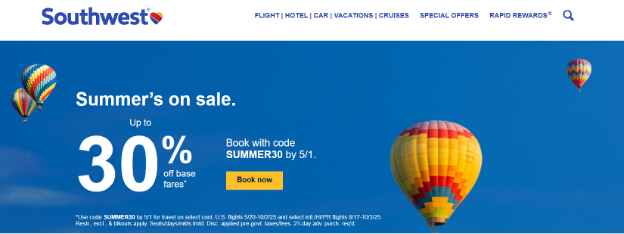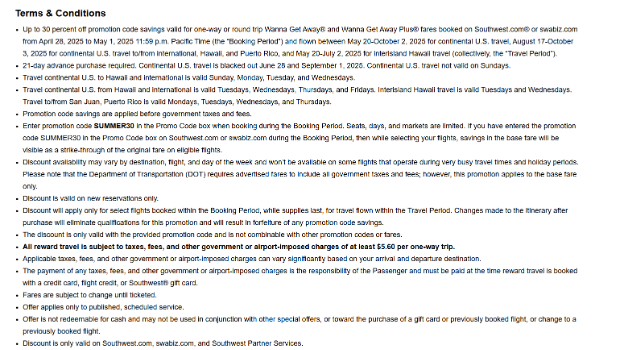In this edition: Why loyalty doesn’t work when it’s complex, mundane or invisible
This edition of Loyalty Tidbits covers a few scenarios when loyalty just doesn’t work. It’s not that the concept doesn’t work. We always assume positive intent, so each of these examples had its chance to make a positive impact with customers. In these examples, we are talking about when execution gets in the way of success.
One of the subtle beauties of loyalty marketing is that we only need to put on our consumer hat and browse our inbox or visit a store / website to observe how differently brands approach loyalty strategy and execution.
In this Loyalty Tidbits (you can read the previous edition here) we show you that loyalty is challenged for success when:
- When Loyalty is complex (Southwest Airlines)
- When Loyalty is Mundane (Pros Closet)
- When Loyalty is invisible (Albertsons)
Southwest Airlines Summer Promotion
Shopping for air travel is always an adventure as travelers must navigate the byzantine airfare structures offered by their favorite air carriers. Upon landing on the main page of Southwest Airlines this week, I was delighted to see a splashy announcement of a Summer 30 Promotion.

After landing on the itinerary of my choice, I added the “Summer30” coupon code and proceeded to purchase the fare. The message came back that this fare did not qualify for the promotion. I’m not sure that all consumers take time to do this, but I clicked through to review the terms and conditions of the promotion. You’ll see from the graphic below that they are quite lengthy. Can we say complex?

I decided to query Southwest on a more complex flight pairing where the fare would be higher, and I could take advantage of the promotion. After finding a flight pair that tallied up to around $290, I entered the code and clicked “purchase”. To my surprise, the value of the discount yielded by the Summer 30 promotion on this fare was $7.40, hardly enough to cover the coffee and pastry that I would inevitably buy in the concourse pre-flight.
The next day I received a reminder email that the Summer 30 promotion was still available. My only solace in this experience was that the promotion was expiring the next day. This enticing promotion was disappointing as it was too hard to apply and when it did work, didn’t equate to much value.
Complexity killed an otherwise promising promotion.
The Pros Closet Falls Prey to the Shopify Effect on Loyalty
There’s a joke among cyclists that the only time you want your significant other to know the value of all the bikes hanging in your garage is after you die. Only you knew how much you had spent on each of your road/gravel/triathlon bikes, and even though each one came home with a tale of “what a great deal I got”, you’d hate to see your partner lose out on thousands of dollars when you are gone and the bikes are sold.
Yes, bikes are expensive, and the Pros Closet was founded as an online marketplace to help cyclists find pre-owned bikes at a reasonable price. They created an innovative Certified Pre-Owned bike process where expert mechanics meticulously inspect every part on every bike to ensure that high-quality bikes stay in motion longer.
When this innovative brand announced a new rewards program recently, we were interested in investigating their approach. That’s where the innovation ended. The program is points based and awards points at 1 per each dollar spent. There is an enrollment bonus and opportunities to earn points for various engagement activities (follows on social channels, joining their Strava Club and submitting bikes, frames and wheels). One hundred points can be redeemed for 4 dollars, so the effective funding rate is 4%, better than 1% but maybe insufficiently transparent in a category where the average purchase is denominated in the thousands of dollars.
In recent months we have observed something that for now, we term the “Shopify Effect” on loyalty. If you survey a dozen DTC retailers trading on the Shopify platform, you’ll see a common loyalty program structure. They are all points-based systems with an enrollment discount, 1 percent funding rate and very little else to drive engagement, create zero-party data or ensure customer retention over the long term. We have reason to believe that these boring program structures are not limited by Shopify software, but are the result of over-simplified configuration and execution. More on that in a future article.
The Pros Closet rewards program is not operating on Shopify (at least from our look at their UTM codes) but the model seems inspired by the dumbing down of loyalty known as the Shopify Effect. DTC retailers can do better, and their loyalty efforts don’t have to be limited by the mundane and boring structures of the 1980’s. We have plenty of answers to help DTC retailers improve their customer loyalty game. Just ask us.
Albertsons for U™ Offers Automatic Discounts – and Risks Becoming Invisible
In an article just received from gamification expert Steve Bocska, Founder PUG Interactive, he writes about a recent strategic shift in the Albertsons for U™ program.
The new approach promises more automatic discounts and simplified customer-friendly savings. As Steve comments, this update may sound alluring at first glance, but by turning loyalty into something passive, invisible and ultimately forgettable, he fears the Albertsons’ strategy could disastrously collapse into customer indifference and become just another silent discount program customers neither notice nor appreciate.
The article continues to comment that Albertsons for U™ loyalty program claims to promise big savings, but in practice the experience feels less like a satisfying, reciprocal brand-customer relationship and more like an unpaid part-time job. Each week, members must manually clip dozens — sometimes hundreds — of digital coupons if they want to access all the advertised discounts. It’s less “shop smart” and more “play whack-a-mole with your grocery list.” Miss a click? Miss a discount. It’s a rather tedious ritual that risks leaving customers feeling more anxious than appreciated.
Keep an eye out for the entire article dissecting the Albertsons program in the next few weeks. A key takeaway to ponder in the interim is that removing all friction from the loyalty experience can have its downfalls. If you want to read about the value of friction in loyalty programs, read this article Funstration: How I Frustrate Customers for a Living.
And remember, removing all friction from the loyalty experience means that your program can become invisible to your customers. When that happens, customers can quickly disappear.